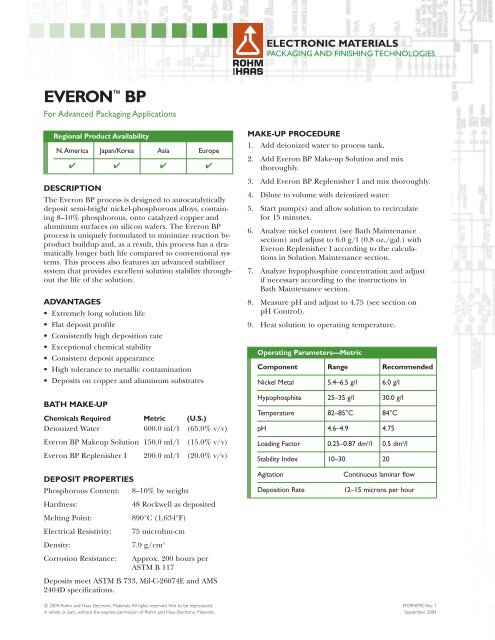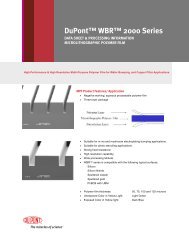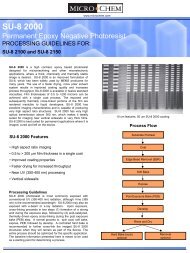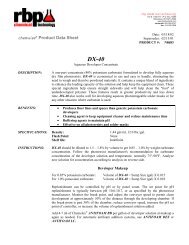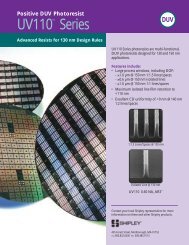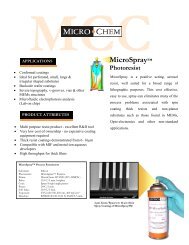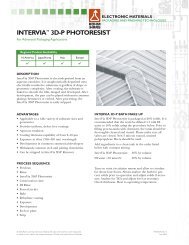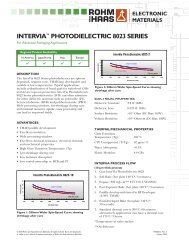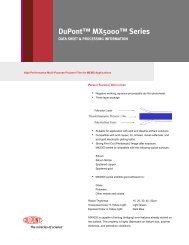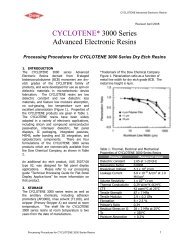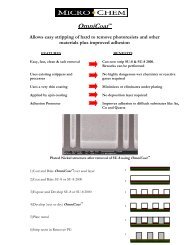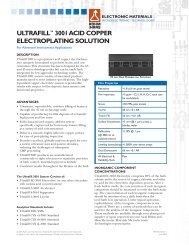EVERON™ BP - MicroChem
EVERON™ BP - MicroChem
EVERON™ BP - MicroChem
You also want an ePaper? Increase the reach of your titles
YUMPU automatically turns print PDFs into web optimized ePapers that Google loves.
EVERON <strong>BP</strong><br />
For Advanced Packaging Applications<br />
Regional Product Availability<br />
N.America Japan/Korea Asia Europe<br />
✔ ✔ ✔ ✔<br />
DESCRIPTION<br />
The Everon <strong>BP</strong> process is designed to autocatalytically<br />
deposit semi-bright nickel-phosphorous alloys, containing<br />
8–10% phosphorous, onto catalyzed copper and<br />
aluminum surfaces on silicon wafers. The Everon <strong>BP</strong><br />
process is uniquely formulated to minimize reaction byproduct<br />
buildup and, as a result, this process has a dramatically<br />
longer bath life compared to conventional systems.<br />
This process also features an advanced stabilizer<br />
system that provides excellent solution stability throughout<br />
the life of the solution.<br />
ADVANTAGES<br />
Extremely long solution life<br />
Flat deposit profile<br />
Consistently high deposition rate<br />
Exceptional chemical stability<br />
Consistent deposit appearance<br />
High tolerance to metallic contamination<br />
Deposits on copper and aluminum substrates<br />
BATH MAKE-UP<br />
Chemicals Required Metric (U.S.)<br />
Deionized Water 600.0 ml/l (65.0% v/v)<br />
Everon <strong>BP</strong> Makeup Solution 150.0 ml/l (15.0% v/v)<br />
Everon <strong>BP</strong> Replenisher I 200.0 ml/l (20.0% v/v)<br />
DEPOSIT PROPERTIES<br />
Phosphorous Content: 8–10% by weight<br />
Hardness: 48 Rockwell as deposited<br />
Melting Point: 890°C (1,634°F)<br />
Electrical Resistivity: 75 microhm-cm<br />
Density: 7.9 g/cm3 Corrosion Resistance: Approx. 200 hours per<br />
ASTM B 117<br />
Deposits meet ASTM B 733, Mil-C-26074E and AMS<br />
2404D specifications.<br />
© 2004 Rohm and Haas Electronic Materials. All rights reserved. Not to be reproduced,<br />
in whole or part, without the express permission of Rohm and Haas Electronic Materials.<br />
MAKE-UP PROCEDURE<br />
1. Add deionized water to process tank.<br />
2. Add Everon <strong>BP</strong> Make-up Solution and mix<br />
thoroughly.<br />
3. Add Everon <strong>BP</strong> Replenisher I and mix thoroughly.<br />
4. Dilute to volume with deionized water.<br />
5. Start pump(s) and allow solution to recirculate<br />
for 15 minutes.<br />
6. Analyze nickel content (see Bath Maintenance<br />
section) and adjust to 6.0 g/l (0.8 oz./gal.) with<br />
Everon Replenisher I according to the calculations<br />
in Solution Maintenance section.<br />
7. Analyze hypophosphite concentration and adjust<br />
if necessary according to the instructions in<br />
Bath Maintenance section.<br />
8. Measure pH and adjust to 4.75 (see section on<br />
pH Control).<br />
9. Heat solution to operating temperature.<br />
Operating Parameters—Metric<br />
Component Range Recommended<br />
Nickel Metal 5.4–6.5 g/l 6.0 g/l<br />
Hypophosphite 25–35 g/l 30.0 g/l<br />
Temperature 82–85°C 84°C<br />
pH 4.6–4.9 4.75<br />
Loading Factor 0.25–0.87 dm 2 /l 0.5 dm 2 /l<br />
Stability Index 10–30 20<br />
Agitation Continuous laminar flow<br />
Deposition Rate 12–15 microns per hour<br />
PF04N090, Rev. 1<br />
September 2004
2<br />
EVERON <strong>BP</strong><br />
Operating Parameters—U.S.<br />
Component Range Recommended<br />
Nickel Metal 0.72–0.85 oz./gal. 0.8 oz./gal.<br />
Hypophosphite 3.7–4.6 oz./gal. 4.0 oz./gal.<br />
Temperature 180–186°F 183°F<br />
pH 4.6–4.9 4.75<br />
Loading Factor 0.10–0.35 ft 2 /gal. 0.2 ft 2 /gal.<br />
Stability Index 10–30 20<br />
Agitation Continuous laminar flow<br />
Deposition Rate 480–600 microinches per hour<br />
BATH MAINTENANCE<br />
Replenishment<br />
To ensure correct operation of the Everon <strong>BP</strong> electroless<br />
nickel process, the solution concentration should<br />
be maintained between 90 and 105% activity. For production<br />
operations processing significant surface area<br />
through the Everon <strong>BP</strong> solution, the use of Rohm and<br />
Haas Electronic Materials’ Ronalyser NI-pH Mk II is<br />
strongly recommended. This is a two channel electroless<br />
nickel controller that analyses and maintains the<br />
metal content and pH values at preset levels. See Rohm<br />
and Haas Electronic Materials Technical Sales<br />
Representative for the setup and operation of the<br />
controller.<br />
The following analytical procedure is essential for controlling<br />
the Everon Electroless Nickel bath components.<br />
NICKEL METAL<br />
I. Equipment<br />
a) 10 ml Class A transfer pipette<br />
b) 250 ml Erlenmeyer flask<br />
c) 25 ml graduated cylinder<br />
d) 25 or 50 ml burette<br />
II. Reagents<br />
a) Concentrated ammonium hydroxide<br />
b) Murexide indicator (0.2g Murexide ground<br />
with 100g sodium chloride)<br />
c) 0.05M EDTA solution<br />
III. Procedure<br />
a) Pipette a 10 ml sample of cooled electroless<br />
nickel working solution into a 250 ml<br />
Erlenmeyer flask.<br />
b) Add 100 ml of deionized water.<br />
c) Add 15 ml of ammonium hydroxide.<br />
d) Add two spatula tips of murexide indicator. The<br />
solution should change to a yellow-brown color.<br />
Excessive amounts of indicator can obscure the<br />
endpoint.<br />
e) Titrate immediately with 0.05M EDTA until the<br />
solution changes from brown to a blue-violet<br />
endpoint.<br />
IV. Calculation<br />
g/l Nickel metal = ml Titre x 0.293<br />
Target = 6.0 g/l<br />
Upon determination of the nickel concentration,<br />
replenishment of the solution may be accomplished by<br />
using the following formulas:<br />
Metric<br />
ml/l addition of<br />
Everon <strong>BP</strong> Replenisher I required =<br />
(6.0 - Nickel Concentration in g/l) x 33.48<br />
ml/l addition of<br />
Everon <strong>BP</strong> Replenisher II required =<br />
(6.0 - Nickel Concentration in g/l) x 16.74<br />
U.S.<br />
fl. oz./gal. of<br />
Everon <strong>BP</strong> Replenisher I required =<br />
(0.8 - Nickel Concentration in oz./gal.) x 32.0<br />
fl. oz./gal. of<br />
Everon <strong>BP</strong> Replenisher II required =<br />
(0.8 - Nickel Concentration in oz./gal.) x 16.0<br />
Everon <strong>BP</strong> Replenishers I and II should always be<br />
added in a ratio of 2:1. Replenishment materials may be<br />
added to the solution at operating temperature according<br />
to the following guidelines:<br />
1. Always add replenishers slowly with vigorous<br />
agitation.<br />
2. Never add replenishers to the bath directly over<br />
heaters or parts being processed.<br />
3. Do not make additions of more than 20% of<br />
the total solution volume at one time. If a larger<br />
addition is required, add the replenishers in<br />
increments of 10% while plating work in the<br />
solution.<br />
For ease of calculation the following charts can be used<br />
to determine the quantities of replenishers required.
3<br />
EVERON <strong>BP</strong><br />
Replenishment Schedule (100 liter bath)—Metric<br />
% Activity Nickel Replenisher I Replenisher II<br />
Conc.<br />
105% 6.3 g/l 0 0<br />
100% 6.0 g/l 0 0<br />
95% 5.7 g/l 1.0 liters 0.5 liters<br />
90% 5.4 g/l 2.0 liters 1.0 liters<br />
85% 5.1 g/l 3.0 liters 1.5 liters<br />
80% 4.8 g/l 4.0 liters 2.0 liters<br />
75% 4.5 g/l 4.0 liters 2.0 liters<br />
Replenishment Schedule (100 gallon bath)—U.S.<br />
% Activity Nickel Replenisher I Replenisher II<br />
Conc.<br />
105% 0.84 oz./gal. 0 0<br />
100% 0.80 oz./gal. 0 0<br />
95% 0.76 oz./gal. 4 qts. 4 qts.<br />
90% 0.72 oz./gal. 8 qts. 4 qts.<br />
85% 0.68 oz./gal. 12 qts. 6 qts.<br />
80% 0.64 oz./gal. 16 qts. 8 qts.<br />
75% 0.60 oz./gal. 16 qts. 8 qts.<br />
YIELD AND REPLENISHMENT BY WORKLOAD<br />
If workload surface area is accurately known, replenishments<br />
can be made at a rate of 615 ml (20.8 fl. oz.) of<br />
Replenisher I and 307.5 ml (10.4 fl. oz.) of Replenisher<br />
II per mil. ft 2 plated. If the Everon <strong>BP</strong> nickel metal content<br />
falls below 3.6 g/l (0.48 oz./gal.), readjustment of<br />
the chemical balance of the solution is required. Please<br />
consult your Rohm and Haas Electronic Materials<br />
Service Engineer for specific recommendations about<br />
this procedure.<br />
HYPOPHOSPHITE<br />
Sodium hypophosphite is maintained by additions of<br />
Everon <strong>BP</strong> Replenisher I according to nickel metal<br />
analysis. A weekly analytical check of hypophosphite<br />
concentration should be made using the method<br />
described below. Everon <strong>BP</strong> Reducer is used to make<br />
any required supplemental additions of hypophosphite<br />
based on the analytical results. A 1 ml/l addition will<br />
raise the concentration by 0.2 g/l.<br />
I. Equipment<br />
a) 5 ml pipette<br />
b) 50 ml pipette<br />
c) 250 glass stoppered iodine flask<br />
d) 25 ml graduated cylinder<br />
II. Reagents<br />
a) Hydrochloric acid solution , (50% v/v)<br />
b) Iodine solution, 0.1N<br />
c) Sodium thiosulfate solution, 0.1N<br />
d) Standard starch indicator (optional)<br />
III. Procedure<br />
a) Pipette 5 ml of plating solution into glass-stoppered<br />
iodine flask.<br />
b) Add 30 ml hydrochloric acid solution into the<br />
flask.<br />
c) Pipette 50 ml of 0.1N iodine solution.<br />
Immediately stopper flask and mix thoroughly.<br />
Place flask in a cool dark place for 30 ±1<br />
minutes.<br />
d) Titrate with 0.1N sodium thiosulfate solution<br />
until pale yellow color is observed.<br />
e) Add 2 ml starch indicator to solution flask<br />
(optional).<br />
f) Continue to carefully titrate with sodium thiosulfate<br />
solution until the color changes from<br />
blue-purple to a colorless endpoint.<br />
Note: The endpoint appears slowly so care must be<br />
taken to avoid overtitrating. Sample temperatures<br />
out of range (72 ±3°F) will produce inaccurate<br />
results.<br />
IV. Calculation<br />
[5.0 - (ml Titrant x 0.1)] x 10.58 =<br />
Sodium Hypophosphite (g/l)<br />
Target = 30 g/l when Ni is at 6.0 g/l.<br />
Otherwise, Hypo to Ni ratio should be 5:1.<br />
Everon Reducer Concentrate is used to make any<br />
required supplemental additions of sodium hypophosphite<br />
based on the analytical results. A 1 ml/l addition<br />
will raise the concentration by 0.2 g/l.
4<br />
EVERON <strong>BP</strong><br />
PH CONTROL<br />
The pH of the solution should be maintained between<br />
4.6 and 4.9. Always measure pH at room temperature.<br />
To raise the pH of the solution, use either a 50% (v/v)<br />
ammonium hydroxide solution or a 240 g/l solution of<br />
potassium carbonate. Exercise caution when adding<br />
potassium carbonate to the bath as carbon dioxide will<br />
evolve. To lower the pH of the solution, use a 10%<br />
(v/v) solution of sulfuric acid.<br />
When making pH adjustments at operating temperature,<br />
add small, frequent amounts of pH adjuster. Use<br />
extreme caution when mixing and handling sulfuric<br />
acid solutions as the reaction is always exothermic (heat<br />
producing) and temperature may exceed 70°C (158°F).<br />
Always add acid to water and mix thoroughly during<br />
addition. Allow this mixture to cool to room temperature<br />
before making additions to the plating solution.<br />
I. Equipment<br />
pH meter (multiple point calibration capability,<br />
preferably with automatic temperature<br />
compensation)<br />
II. Reagents<br />
a) Buffer solution, pH = 4.0<br />
b) Buffer solution, pH = 7.0<br />
III. Procedure<br />
a) Rinse electrodes with DI water.<br />
b) Buffer pH meter with a 2 point calibration with<br />
the reagents listed above.<br />
c) Rinse electrodes with DI water.<br />
d) If there is no temperature compensation for<br />
the pH meter, cool the sample to exactly 25°C<br />
or to the temperature of the buffer solutions<br />
used to standardize the meter. If temperature<br />
compensation is available, cool the sample such<br />
that the temperature is within the range of<br />
25–30°C (77–86°F).<br />
e) After rinsing off the electrodes with DI water,<br />
insert the pH probe into the working bath solution.<br />
Allow the solution to stabilize (when pH<br />
drift is minimal, that is no change in a 5–10 sec.<br />
time frame).<br />
f) Record value in chart<br />
g) Rinse electrodes with DI water, and return the<br />
probe set tot he cup partially filled with 7.0<br />
buffer standard.<br />
Target = pH 4.60–2.90<br />
BATH TEMPERATURE<br />
Operating temperature of the electroless nickel solution<br />
should be maintained at 82–85°C (180–186°F).<br />
Temperatures below 82°C (180°F) will result in reduced<br />
plating rate while temperatures above 93°C (200°F)<br />
may result in accelerated tank plate out and/or decomposition<br />
of certain bath constituents. If the solution is<br />
maintained at operating temperature during extended<br />
periods when no work is being processed, thermal<br />
decomposition of the reducing agent may occur, resulting<br />
in excessive consumption of chemicals and an<br />
unnecessary loss in economy of operation.<br />
LOADING FACTOR<br />
Rohm and Haas Electronic Materials recommends for<br />
the optimum performance of the Everon <strong>BP</strong> solution a<br />
consistent workload surface area per volume of solution.<br />
Consistent loading will result in the uniform operation<br />
of the Ronalyser, effective solution control and<br />
uniform deposit quality.<br />
Recommended Control Schedule<br />
Analysis of Procedure Frequency<br />
Nickel Metal Volumetric AP 72059 Hourly<br />
Hypophosphite Volumetric AP 72059 Weekly<br />
Orthophosphite Volumetric Hourly<br />
pH Electrometric Hourly<br />
Metallic Contamination Atomic Absorption As Required<br />
Deposition Rate X-ray, micrometer Daily<br />
Deposit Thickness X-ray, Beta backscatter, Daily<br />
Cross section<br />
Stability Index Volumetric Daily<br />
METALLIC IMPURITIES<br />
The maximum tolerable level of metallic contaminants<br />
are listed below:<br />
As 0.3 ppm<br />
Cd 2 ppm<br />
Cr 2 ppm<br />
Cr (+3) 20 ppm<br />
Cu 10 ppm<br />
Fe 100 ppm<br />
Pb 2 ppm<br />
Pd 3 ppm<br />
Sb 2 ppm<br />
Sn (+2) 5 ppm<br />
Zn 120 ppm
5<br />
EVERON <strong>BP</strong><br />
PRE-TREATMENT<br />
Preparation of the substrate for electroless nickel plating<br />
is essential in achieving the benefits of the coating.<br />
Inadequate cleaning and/or poorly designed pretreatment<br />
procedures may result in poor adhesion, discoloration,<br />
roughness or porosity of the deposit and premature<br />
failure of the coating. The Rohm and Haas<br />
Electronic Materials Everon <strong>BP</strong> process is designed to<br />
plate nickel onto palladium catalyzed copper surfaces,<br />
or zincate conditioned Aluminum surfaces of silicon<br />
wafers. For plating on copper Everon <strong>BP</strong> Catalyst is<br />
used to provide the initial palladium layer and promote<br />
the complete and uniform initiation of nickel. For plating<br />
on aluminum, AluPrep <strong>BP</strong> Zincate or DuraPrep Z-<br />
20 is used to catalyze the nickel reaction on the aluminum<br />
substrate.<br />
In order to maximize solution life span and deposit<br />
integrity, it is important to provide thorough rinsing<br />
prior to entry into the electroless nickel solution. Please<br />
contact your Rohm and Haas Electronic Materials<br />
Service Engineer for rinsing and cleaning recommendations<br />
for specific methods of operation.<br />
PRODUCT DATA (TYPICAL PROPERTIES)<br />
Everon <strong>BP</strong> Make-up Solution<br />
Appearance: Colorless<br />
pH: 6.0<br />
Specific Gravity: 1.217<br />
Everon <strong>BP</strong> Replenisher I<br />
Appearance: Green<br />
pH:
6<br />
EVERON <strong>BP</strong><br />
Circuit Board Technologies<br />
CMP Technologies<br />
Microelectronic Technologies<br />
Packaging and Finishing Technologies<br />
For locations and information please visit; http://electronicmaterials.rohmhaas.com<br />
Everon, DuraPrep, Rohm and Haas, and Rohm and Haas Electronic Materials are trademarks of Rohm and Haas Company, Philadelphia, PA, USA, or its affiliates.<br />
UNITED STATES<br />
Marlborough, MA<br />
Tel: 800.832.6200<br />
Fax: 508.485.9113<br />
Freeport, NY<br />
Tel: 800.645.2996<br />
Fax: 516.868.8074<br />
JAPAN<br />
Tokyo<br />
Tel: +81.3.5213.2910<br />
Fax: +81.3.5213.2911<br />
ASIA<br />
Hong Kong<br />
Tel: +852.2680.6888<br />
Fax: +852.2680.6333<br />
EUROPE<br />
Paris, France<br />
Tel: +33.1.40.02.54.00<br />
Fax: +33.1.40.02.54.07<br />
For Industrial Use Only.This information is based on our experience and is, to the best of our knowledge, true and accurate. However, since conditions for use and handling of<br />
products are beyond our control, we make no guarantee or warranty, expressed or implied, regarding the information, the use, handling, storage or possession of the products,<br />
or the applications of any process described herein or the results sought to be obtained. Nothing herein shall be construed as a recommendation to use any product in violation<br />
of any patent rights.


